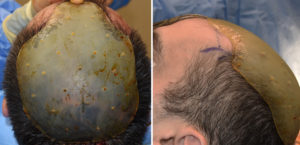Skull implants are a versatile treatment strategy for a variety of head augmentation concerns. Made from the patient’s 3D CT scan they can be designed to provide increases in skull projection that are only limited by the stretch of one’s scalp.
One of the not uncommon indications for custom skull implants is to increase the height across the top of the head. This is requested by both men and women with no significant gender tendency. While such a procedure can be perform equally in either male or female, the male hairline must be considered in the implant’s design is some cases.
While custom skull implants are made with a feathered contoured edge at its perimeter, there is always the risk of a visible transition in non-hair bearing areas. This is most relevant in the forehead and in the any patient where the front edge of the implant extends beyond the hairline. This becomes extremely relevant in the male with a receded/receding hairline which can affect the design of the front edge of the implant.


While the hairline may to be visible in CT scans, preoperative measurements from the lower edge of the brow bones can be useful in making that design consideration.
Dr. Barry Eppley
Indianapolis, Indiana


